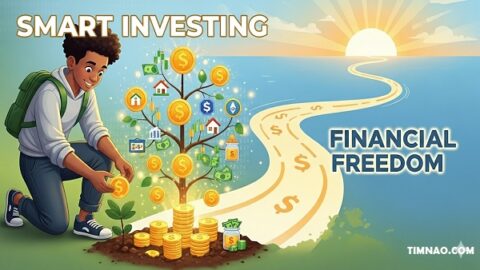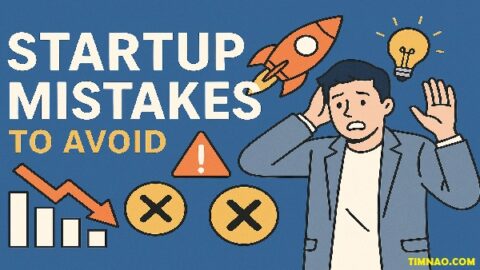💡 From Setbacks to Success: Unleash Your Entrepreneurial Power with Niche Discovery!
Entrepreneurial transformation isn’t just about building a business — it’s about evolving from scattered ideas and frustrating failures into a focused, profitable path that aligns with your strengths and experiences.
If you’ve ever felt like you were hustling in circles, chasing trends that never quite stick, or launching ideas that never fully take off, you’re not alone. Many aspiring entrepreneurs fall into the same trap: thinking they need to start from scratch every time something doesn’t work.
But what if your past mistakes weren’t setbacks — what if they were the very foundation of your future success?
This article introduces a revolutionary way to turn business disappointments into powerful opportunities using a system called the Niche Navigator Method. You’ll discover how to:
-
Mine your past experiences for profitable insights
-
Validate ideas before wasting time or money
-
Build solutions that are both meaningful and market-ready
-
Grow with confidence — because you’re building on a tested foundation
Whether you’ve launched a dozen side hustles or are just recovering from your first failed venture, this guide will show you how to turn setbacks into strategic advantages and finally discover the niche that’s been waiting for you all along.
Now, let’s dive into your roadmap to transformation.👇
🧭 Table of Contents
- 💥 Why Business Failures Are a Hidden Asset
- 🔁 Breaking Free from the Entrepreneurial Loop
- 🧠 Building Your Personal Experience Inventory
- 🧬 Uncovering Your Unique Business DNA
- 🧭 The Niche Navigator Method Explained
- 🚀 Transforming Experience into Profitable Solutions
- 🧪 Validating Your Ideas Before Going All In
- 📊 Scaling What Works with Confidence
- 💎 The Future of Experience-Driven Entrepreneurship
- ✅ Final Action Plan: Your Transformation Starts Now
💥 Why Business Failures Are a Hidden Asset
Entrepreneurial transformation doesn’t begin with a perfect idea—it starts with learning from what didn’t work. For countless aspiring entrepreneurs, failure feels like the end of the road. But in truth, it’s just the beginning of a smarter, more strategic journey.
Hidden Value in “Failed” Ventures
Behind every closed business, rejected pitch, or abandoned project lies a treasure chest of knowledge:
- You’ve learned what your audience doesn’t respond to.
- You’ve tested marketing channels—even if they didn’t work.
- You’ve identified product features that didn’t hit the mark.
- You’ve already paid for market research—through trial and error.
The real power lies in recognizing your experience as an asset rather than baggage.
Real-World Example: Spotify’s Origin Story
Daniel Ek, co-founder of Spotify, didn’t strike gold on his first try. Before building one of the world’s biggest music platforms, he launched and failed multiple times—first a web design agency, then an ad network, and a few others. Each “failure” taught him something about customer pain points, digital trends, and user experience.
Eventually, he realized the music industry was broken: piracy was everywhere, artists were struggling, and users wanted convenience. His failed experiences gave him the perfect lens to disrupt the market.
Turn Your Losses Into Leverage
What if your last business wasn’t a mistake—but a paid internship for your future success?
Here’s how to start reframing failure:
- See every venture as a lesson, not a loss.
- Ask yourself: What did I learn about myself, the market, or my ideal customer?
- Document both what didn’t work—and what got close.
You’re not starting from scratch. You’re starting from experience.
🔁 Breaking Free from the Entrepreneurial Loop
Many first-time entrepreneurs fall into what we call the Hamster Wheel of Hustle. The cycle looks like this:
- Initial Excitement – The idea feels fresh and full of potential.
- Reality Hits – You launch, struggle to get traction, and burn through resources.
- The Pivot Panic – You switch ideas or give up—then start again with something new.
Sound Familiar?
This is common, especially if you’re chasing “hot trends” or mimicking others’ success without grounding it in your own experiences.
The most dangerous part? This loop erodes your confidence and increases burnout.
Sara Blakely’s Game-Changer Mindset
Before founding Spanx, Sara Blakely was selling fax machines door-to-door and faced constant rejection. But instead of seeing her rejections as proof she couldn’t succeed, she treated each interaction as research.
She eventually created a product that addressed a problem she herself experienced—uncomfortable undergarments that didn’t work under white pants. Her solution wasn’t just a product; it was the culmination of years of insights gathered on the ground.
The takeaway? Break the cycle by pausing to reflect, not pivot blindly.
🧠 Building Your Personal Experience Inventory
Your greatest business insight is probably buried in your past. It’s time to dig it up and bring it to light.
What Is an Experience Inventory?
Think of it like an entrepreneur’s version of a resume—but instead of listing jobs, you list ventures, side hustles, product launches, and even abandoned ideas.
For each one, write down:
- What problem you were solving
- What you tried
- What worked (even a little)
- What didn’t
- What feedback you received
Tools You Can Use
Use a spreadsheet, Notion doc, or even pen and paper. Start with these columns:
| Business Name | Year | Goal | Outcome | Lessons Learned |
|---|---|---|---|---|
| Custom Tees Co | 2021 | Sell print-on-demand tees | Low sales | Niche too broad, poor ad targeting |
| Meal Planner App | 2022 | Subscription nutrition tool | 200 users but low retention | Too complex; users needed simplicity |
Now you’re not looking at a string of failures. You’re staring at a living database of market intelligence.
🧬 Uncovering Your Unique Business DNA
Just like your fingerprints, your entrepreneurial journey is one of a kind.
What Is Your Business DNA?
It’s the collection of:
- Your natural strengths
- Your hard-won insights
- Your industry exposure
- Your personality traits that influence how you build
Identify Your Core Strength Patterns
Ask yourself:
- Which projects energized me the most?
- Where did I consistently get positive feedback?
- What did I enjoy solving, even if I didn’t make money?
This introspection helps you avoid chasing the wrong opportunities and focus on ones aligned with who you really are.
Real-Life Pivot: Sarah Chen and FreshTrack
After managing a struggling restaurant, Sarah Chen began tracking inventory waste obsessively. She didn’t know it yet, but that spreadsheet would become the backbone of her future SaaS platform: FreshTrack. What seemed like over-detailing turned into a scalable restaurant management system used by 500+ businesses.
That’s the power of decoding your Business DNA.
🧭 The Niche Navigator Method Explained
So far, you’ve mined insights from your past ventures and decoded your unique entrepreneurial DNA. Now it’s time to turn all of that into a systematic process that helps you build smarter, faster, and with more precision.
Enter the Niche Navigator Method — a proven roadmap for turning real-world experience into scalable business opportunities. This isn’t about guesswork or theory. It’s a battle-tested method designed for entrepreneurs who are tired of starting over and ready to build with intention.
What Is the Niche Navigator Method?
It’s a 5-phase framework to help you:
- Navigate Past Experiences – Turn your failures into structured insights.
- Identify Market Gaps – Discover real needs based on your unique exposure.
- Create a Solution Blueprint – Design a product/service rooted in authenticity.
- Hypothesize and Test – Rapidly validate your idea without going broke.
- Execute with Precision – Launch with clarity and confidence.
Each phase builds on the one before it. And when done right, this method will help you stop spinning your wheels and start building a business that aligns with who you are and what the market actually wants.
How It Was Born: The Story of Sarah Martinez
Sarah had launched three different startups. All of them failed. But instead of giving up, she analyzed everything: the customer feedback, the products that didn’t sell, even the moments that made her feel stuck. Then she noticed a pattern — small businesses repeatedly struggled with positioning themselves in niche markets.
That insight helped her develop a new consulting framework, which eventually evolved into the Niche Navigator Method. It didn’t just work for her. Over 1,000 entrepreneurs have since used it to pivot, niche down, and scale with confidence.
Your next breakthrough could come from doing exactly what Sarah did: mapping your experience and using it as the foundation for growth.
🚀 Transforming Experience into Profitable Solutions
The big shift comes when you stop asking “What product can I sell?” and start asking “What problem am I uniquely equipped to solve?”
This is the core of entrepreneurial transformation—and where your lived experience becomes a business superpower.
Real-World Transformation: Reed Hastings and Netflix
Reed Hastings didn’t create Netflix because he wanted to stream movies. He built it after being charged a $40 late fee for a VHS rental. That moment of frustration—combined with his background in software engineering—led to one of the most innovative business models of the century.
It wasn’t an invention born in a lab. It was a solution born out of personal experience and validated market demand.
So how do you do the same?
Step 1: Design Your Solution Blueprint
A solid solution starts with a deep understanding of the problem, not just a cool idea.
Use this simple framework:
| Element | Your Response |
|---|---|
| What is the core problem? | e.g., “Solopreneurs can’t manage leads effectively” |
| What personal insight do I have? | “I struggled with scattered spreadsheets & lost leads” |
| Why do I care about solving this? | “Because I wasted time and missed clients” |
| What have others missed? | “Most tools are too complex or built for teams” |
| How is my solution different? | “Simple, AI-powered lead tracker for solopreneurs” |
Step 2: Create Your “Value Stack”
This is what makes your solution irresistible. It’s more than just features. It’s the transformation you offer.
Your stack might look like:
- Core Offer: The main product/service
- Support Layer: Templates, guides, onboarding help
- Credibility Layer: Your backstory, experience, results
- Bonus Value: Fast-action bonuses, community, extended support
When you build from experience, your offer doesn’t just work—it resonates.
Step 3: Align With Your Audience
Don’t try to help everyone. Instead, focus on people who resonate with your story, relate to your struggle, and are already looking for help.
Ask yourself:
- Who am I perfectly positioned to serve?
- What do they need that others overlook?
- What tone, format, or delivery would speak directly to them?
This clarity allows you to build something meaningful — not generic.
🧪 Validating Your Ideas Before Going All In
You’ve got a clear solution idea. But here’s where many new entrepreneurs fall into a trap: they launch too fast without testing. You need real-world validation — fast, affordable, and effective.
Why Guessing Is Expensive
Building a full product before testing is like investing in a house before checking the land for sinkholes. It leads to:
- Wasted time
- Burned resources
- Crushed confidence
That’s why we validate with micro-tests—tiny experiments to prove your assumptions.
The 3-Day Validation Sprint
You can validate nearly any idea in just 3 days:
Day 1 – Create a “Smoke Test”
- Launch a landing page with your offer
- Add a short video or compelling copy
- Include a CTA like “Join the waitlist” or “Book a free call”
Day 2 – Share It in the Right Places
- Niche Facebook groups
- Your personal network
- Reddit communities
- Your email list (if you have one)
Day 3 – Analyze and Decide
- Did people opt-in?
- Did you receive replies or questions?
- Did anyone share it organically?
If yes → Your idea has legs.
If no → You may need to adjust the messaging, not the idea.
Tools to Use for Quick Testing
- Carrd.co – Fast one-page site builder
- MailerLite – Capture emails with automation
- Tally – Create simple feedback forms
- B12.io – AI-powered website builder
- Loom – Record video explanations
These tools require little-to-no code and cost you very little to get started.
Real Story: The Airbnb Validation
The founders of Airbnb didn’t launch with a huge platform. They tested the idea by renting out three air mattresses in their apartment during a local conference. Their test was so successful, it became the foundation of a billion-dollar company.
Your test doesn’t have to be fancy—it just needs to get your offer in front of real people.
📊 Scaling What Works with Confidence
Once you’ve validated your idea and confirmed demand, it’s time to go from micro wins to market momentum. This phase isn’t about doing everything — it’s about doubling down on what works and cutting what doesn’t.
Step 1: Define Your Success Metrics
Scaling doesn’t mean guessing. It means tracking real signals from your early tests. Ask yourself:
- What landing pages had the highest conversion rates?
- Which channels brought in the most engaged leads?
- What messaging got the most replies, DMs, or shares?
Then define your core KPIs (Key Performance Indicators):
| Metric | Why It Matters |
|---|---|
| Conversion Rate | Are people buying/signing up? |
| CAC (Customer Acquisition Cost) | Are you acquiring affordably? |
| LTV (Lifetime Value) | Are you building long-term value? |
| Retention Rate | Are customers sticking around? |
Focus on improving these numbers before expanding into new offers or markets.
Step 2: Simplify, Then Automate
Most beginner entrepreneurs overcomplicate their business. Here’s what scaling actually looks like:
- Focus on ONE validated offer
- Serve ONE clearly defined audience
- Use ONE core sales funnel
Once the system works, begin to automate parts of it:
- Use tools like ConvertKit or MailerLite for automated email nurturing
- Use Zapier to connect your systems
- Use Calendly for booking and qualifying leads
- Use Gumroad or Payhip for digital product delivery
Let technology handle the boring stuff, so you can focus on value creation.
Step 3: Refine Before You Multiply
Before you launch a new product, audience, or ad campaign, ask:
- Is my current funnel converting at least 10%?
- Have I systemized my onboarding or delivery?
- Are my customer testimonials ready for scale?
Scaling too early is like stepping on the gas in a car that hasn’t been serviced.
Master one system — then grow.
💎 The Future of Experience-Driven Entrepreneurship
The entrepreneurial world is changing fast. The age of generic, copycat businesses is dying. The future belongs to those who build from lived experience, AI-enhanced insight, and authentic expertise.
Let’s explore how entrepreneurial transformation is evolving.
🔮 Trend 1: AI-Powered Experience Mapping
Soon, entrepreneurs will use AI not just for marketing—but to map their own experiences into business models. Platforms will:
- Track every venture you’ve tried
- Extract patterns from your wins and losses
- Match you with underserved markets based on your story
This means your business ideas will soon be tailored to you — not scraped from Reddit or YouTube.
🌐 Trend 2: Personalized Market Validation Tools
Instead of building blindly, entrepreneurs will use:
- Smart validation bots that run experiments in real time
- Predictive models that simulate customer behavior
- Tools like ChatGPT or Claude to refine positioning and messaging instantly
Validation won’t take months — it will take minutes.
💼 Trend 3: Experience-as-a-Service (EaaS)
In the next 5 years, your past failures and career stories will become marketable assets. Imagine platforms like:
- “LinkedIn for Business Failures” where founders license insights
- Crowdsourced solution databases
- Peer-led startup accelerators focused on real-world case studies, not just pitch decks
You won’t need to be an MBA or coder. You’ll just need documented experience and a framework to package it.
Your story will be your startup.
✅ Final Action Plan: Your Transformation Starts Now
You’ve seen how experience can fuel insight. You’ve explored how to reframe failure, validate ideas, and build something meaningful. But now comes the most important part — action.
Here’s your step-by-step transformation roadmap:
✍️ Step 1: Build Your Experience Inventory
Time required: 1 hour
- List every business, side hustle, or freelance project you’ve tried
- Document what worked, what didn’t, and what you learned
- Look for recurring themes in customer feedback or obstacles
Use a simple Google Sheet or Notion template to organize it.
🔍 Step 2: Find Your Hidden Strengths
Time required: 30–45 mins
Ask:
- What energizes me during a project?
- What do others always ask me for help with?
- Where have I already created impact—even if unpaid?
These are the raw materials of your niche advantage.
📈 Step 3: Identify Market Gaps You Can Fill
Time required: 1–2 hours
- Use Exploding Topics or Google Trends
- Join niche Reddit or Facebook groups
- Read competitor reviews on Amazon or G2 — look for complaints
Then ask: How does my experience uniquely equip me to solve this problem better?
🧪 Step 4: Run a 3-Day Validation Sprint
Time required: 3 days
- Set up a one-page landing site (Carrd, MailerLite, or ConvertKit)
- Share in relevant communities
- Track signups, replies, questions
If people lean in? You’re onto something.
🛠️ Step 5: Design & Launch a Simple MVP
- Build a beta version of your solution
- Offer a limited-time test program to 5–10 people
- Collect feedback, iterate, and start refining
You don’t need perfection. You need traction.
🚀 Step 6: Systemize and Scale
Once your offer is working:
- Build systems (emails, automation, onboarding)
- Raise your prices and improve delivery
- Create simple ads or organic content for reach
Use what worked. Ditch what didn’t. Double down on what your customers love.
✨ Final Thoughts
Your business success doesn’t depend on a secret formula, expensive tools, or luck. It depends on your ability to:
🔹 Reframe failure
🔹 Extract your unique insights
🔹 Serve real people with real problems
That’s the heart of entrepreneurial transformation.
Let this article be your turning point — not just a piece you read, but the blueprint you follow.
Because you’re not starting from zero. You’re starting from experience. 💼🔥









